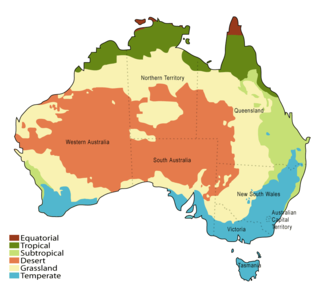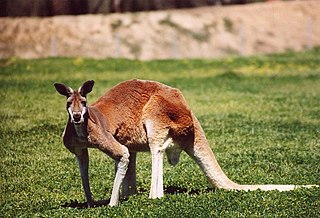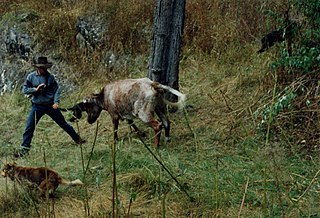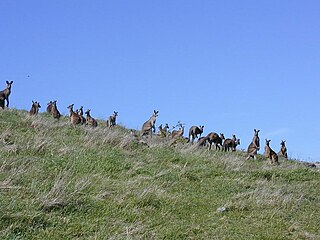 W
WAlthough Australia is mostly arid, the nation is a major agricultural producer and exporter, with over 325,300 employed in agriculture, forestry and fishing as of February 2015. Agriculture and its closely related sectors earn $155 billion-a-year for a 12% share of GDP. Farmers and grazers own 135,997 farms, covering 61% of Australia's landmass. Across the country there is a mix of irrigation and dry-land farming. Australia leads the world with 35 million hectares certified organic, which is 8.8% of Australia's agricultural land and Australia now accounts for more than half (51%) of the world's certified organic agriculture hectares. The success of Australia to become a major agricultural power despite the odds is facilitated by its policies of long-term visions and promotion of agricultural reforms that greatly increased the country's agricultural industry.
 W
WAquaculture in Australia is the country's fastest growing primary industry, accounting for 34% of the total gross value of production of seafood. 10 species of fish are farmed in Australia, and production is dominated by southern bluefin tuna, Atlantic salmon and barramundi. Mud crabs have also been cultivated in Australia for many years, sometimes leading to over-exploitation. Traditionally, this aquaculture was limited to pearls, but since the early 1970s, there has been significant research and commercial development of other forms of aquaculture, including finfish, crustaceans, and molluscs.
 W
WThe Australian Farmer is a statue located in Wudinna, South Australia. Regarded as one of Australia's Big Things, the granite sculpture stands at 8 metres (26 ft) in height, and weighs in the vicinity of 70 tonnes. It took 17 years to produce from initial proposal to the final unveiling in 2009, and two years for the artist, Marijan Bekic, to carve. The stylised work of a farmer represents the early settlers of the region, with carvings symbolising grain and sheep found within the sculpture.
 W
WThe Australian plague locust is a native Australian insect in the family Acrididae, and a significant agricultural pest.
 W
WThe Australian Stockman's Hall of Fame is a museum located in Longreach, Queensland, Australia, which pays tribute to pioneers of the Australian outback. The centre is also dedicated to Australian stockmen who have shown bravery and courage.
 W
WBiofuel is fuel that is produced from organic matter (biomass), including plant materials and animal waste. It is considered a renewable source of energy that can assist in reducing carbon emissions. The two main types of biofuel currently being produced in Australia are biodiesel and bioethanol, used as replacements for diesel and petrol (gasoline) respectively. As of 2017 Australia is a relatively small producer of biofuels, accounting for 0.2% of world bioethanol production and 0.1% of world biodiesel production.
 W
WThe Cairns Group is an interest group of 19 agricultural exporting countries, composed of Argentina, Australia, Brazil, Canada, Chile, Colombia, Costa Rica, Guatemala, Indonesia, Malaysia, New Zealand, Pakistan, Paraguay, Peru, the Philippines, South Africa, Thailand, Uruguay, and Vietnam.
 W
WInvasive species in Australia are a serious threat to the native biodiversity, and an ongoing cost to Australian agriculture. Numerous species arrived with European maritime exploration and colonisation of Australia and steadily since then.
 W
WThe kangaroo industry in Australia is based on the harvesting of the large, abundant species of kangaroos which are sustainably harvested under strict government control. Many professional ecologists support this industry on the basis that it delivers significant environmental benefits. Many argue kangaroos, which are native to Australia, are a more environmentally friendly livestock option than introduced sheep and cattle.
 W
WManzanilla olives ("man-zah-nee-ya") or Manzanillo, also Manzanilla de Sevilla, originally from the area of Seville, Spain, are sometimes referred to as Spanish olives but along with Arbosana, Arbequina, Cacereña, Hojiblanca, Empeltre, and Gordal there are over two hundred varieties grown in Spain as well as other areas.
 W
WA muster (Au/NZ) or a roundup (US) is the process of gathering livestock. Musters usually involve cattle, sheep or horses, but may also include goats, camels, buffalo or other animals. Mustering may be conducted for a variety of reasons including routine livestock health checks and treatments, branding, shearing, lamb marking, sale, feeding and transport or droving to another location. Mustering is a long, difficult and sometimes dangerous job, especially on the vast Australian cattle stations of the Top End, 'The Falls' (gorge) country of the Great Dividing Range and the ranches of the western United States. The group of animals gathered in a muster is referred to as a "mob" in Australia and a "herd" in North America.
 W
WNatural Sequence Farming (NSF) is a method of landscape regeneration devised by the Australian farmer, Peter Andrews, in the 1970s.
 W
WSoil salinity and dryland salinity are two problems degrading the environment of Australia. Salinity is a concern in most states, but especially in the south-west of Western Australia.
 W
WStock and station agencies are businesses which provide a support service to the agricultural community. Their staff who deal with clients are known as stock and station agents. They advise and represent farmers and graziers in business transactions that involve livestock, wool, fertiliser, rural property and equipment and merchandise on behalf of their clients. The number and importance of these businesses fell in the late 20th century.
 W
WA sustainable wildlife enterprise is a farming system that incorporates sustainable use of wildlife to promote conservation. In Australia, landholders work together across boundaries to sustainably harvest or make use of (ecotourism) naturally occurring wildlife populations such as the kangaroo. Important to the concept is that biodiversity and environmental benefit occurs via alternative land uses. Attaching a value to native resources through commercial development has the potential to provide alternative sources of income, especially in areas where traditional systems are no longer as profitable or environmentally sustainable. The Sustainable Wildlife Enterprise system enables farmers to realise the financial value of native wildlife such as the kangaroo and encourages them to manage their land that supports the source of the income without lowering total farm profitability – hence contributing to habitat and biodiversity conservation. The Sustainable Wildlife Enterprise system has been developed in Australia but is based on world-wide experiences.